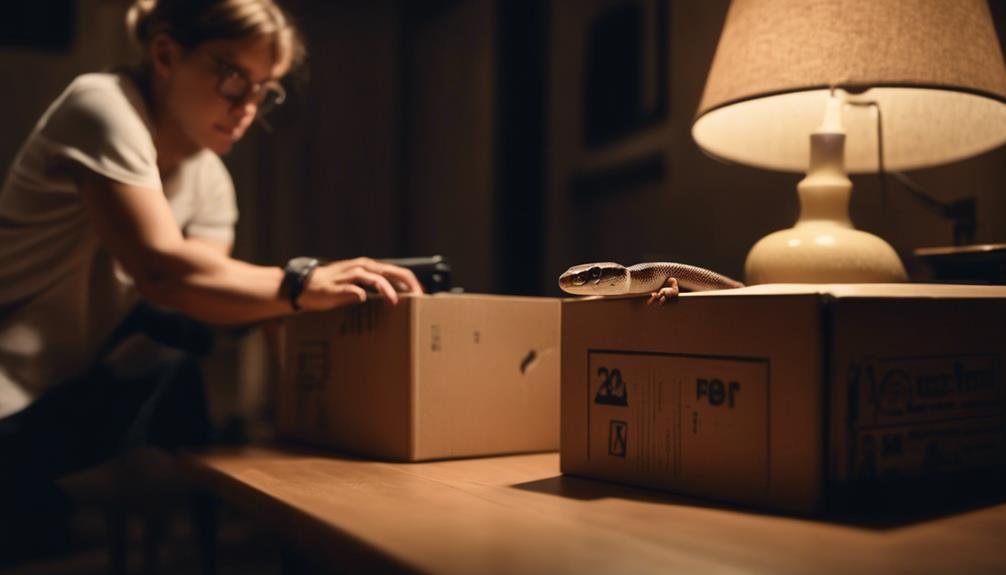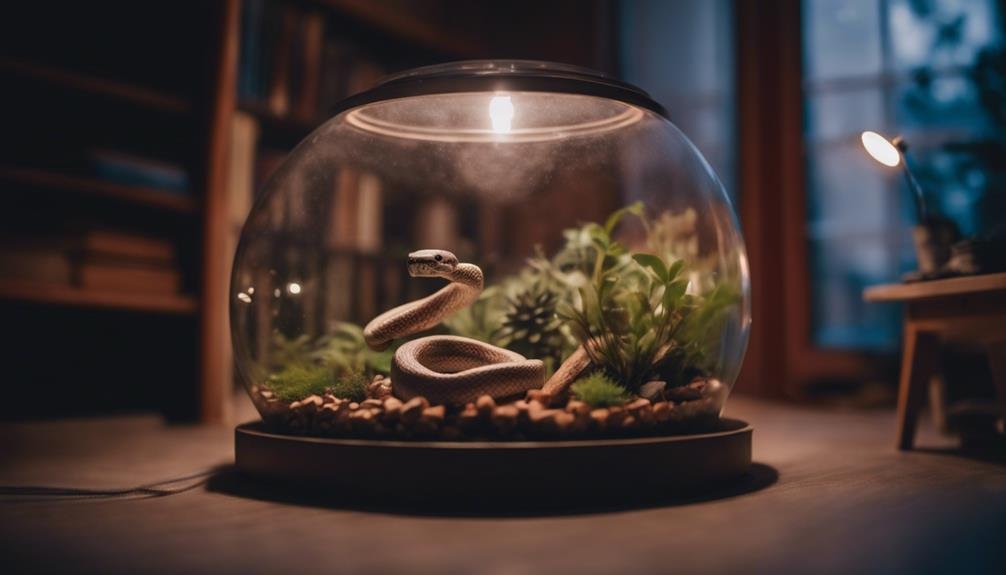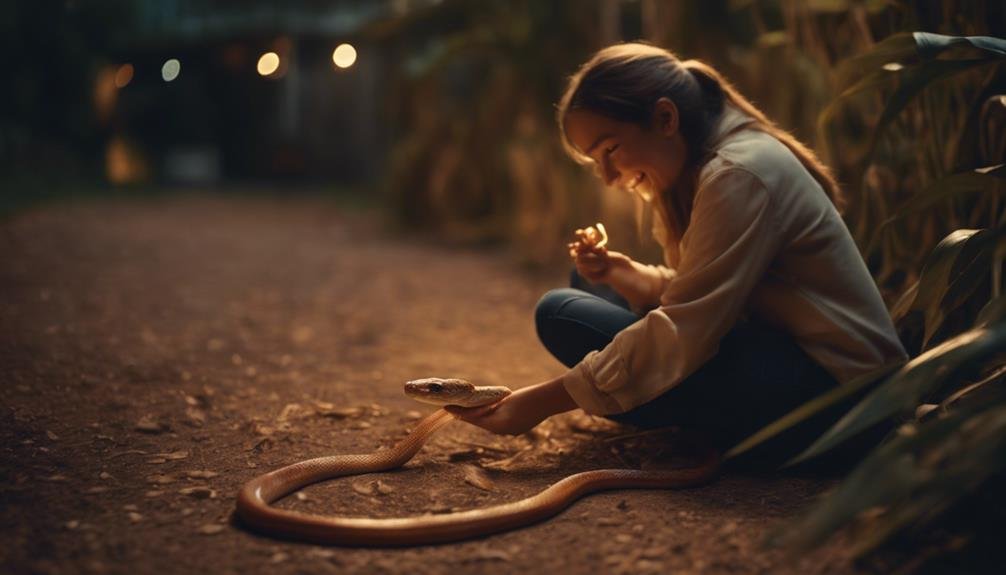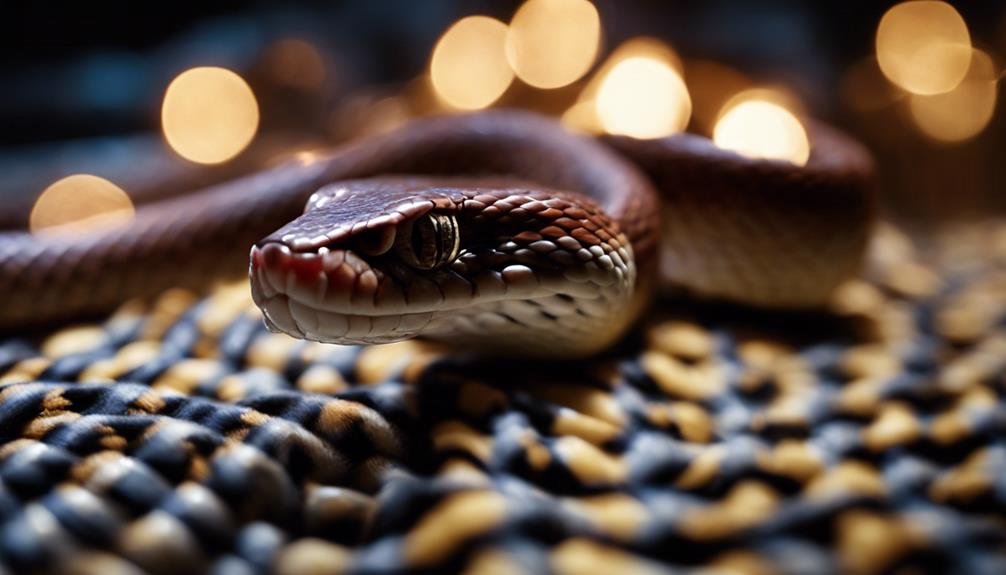Losing your corn snake can be a nerve-wracking experience, but it's important to approach the situation with a calm and methodical mindset. You'll want to start your search in the warmest areas of your home, as these reptiles often seek out heat. Securing other pets and utilizing tools like hand-held mirrors and flashlights can greatly increase your chances of locating your slithery friend. However, the strategies don't stop there. To make sure your efforts are as effective as possible, understanding the subtler signs of a hidden corn snake and the most enticing baits for your traps could make all the difference. Let's explore how you can maximize your search techniques and the preventative measures you can take to avoid future escapes, ensuring your corn snake remains safely within its home.
Key Takeaways
- Check warm spots behind appliances where the snake may seek heat.
- Use flashlights and mirrors to search small spaces and crevices.
- Place heat traps and water bowls to lure the snake out of hiding.
- Secure the area to prevent further escapes and inspect for enclosure flaws.
- Remain patient and create a warm environment to encourage the snake to return.
Don't Panic
Discovering your corn snake has escaped its enclosure may initially be concerning, but it's important to stay calm and focused on the task ahead. Remember, corn snakes can survive outside their enclosure for quite some time, so you've got a window to find your slithery friend.
Start by checking warm spots around your home, such as behind appliances or near any heat sources, as these areas attract snakes seeking comfort and security.
When searching for an escaped snake, it's also vital to look into small spaces. Corn snakes are masters at squeezing into the tiniest of gaps, so leave no stone unturned. Think about places you'd normally overlook: inside drawers, behind bookshelves, or even in the spaces behind wall-mounted frames. Conduct a methodical, room-by-room search, beginning from the last place you saw your snake. This systematic approach increases your chances of locating your escaped pet.
While you're on this mission, it's a good idea to inform your neighbors about your lost snake. This not only helps dispel any fears or myths they might have about snakes but also enlists more eyes to help spot your pet. Remember, finding an escaped corn snake requires patience and thoroughness, so keep at it.
Secure Your Pets
As you search for your lost corn snake, it's important to keep your other pets in mind. Ensuring their enclosures are secure can prevent them from accidentally harming the snake or complicating its recovery.
Having an emergency plan in place for such situations is essential for the safety of all your pets.
Pet Enclosure Safety
Safeguard your pet's safety by properly securing enclosures, especially for free-roaming animals like cats, to prevent any harm to your snake. If your corn snake has escaped from his enclosure, it's likely because he found a spot that wasn't securely locked. Cats, dogs, and even birds can pose significant risks to your snake, especially at night when snakes are most active and looking for warm areas.
To guarantee such situations, always use locks on snake enclosures and never leave them unsupervised when they're roaming free in your home. This simple step not only keeps your snake safe but also ensures that he doesn't wander off into potentially dangerous situations.
Emergency Plan Essentials
In the event of an escape, it's important to have an emergency plan that includes securing your pets to prevent any harm to your missing corn snake. When trying to find a lost corn snake, remember, preventing a snake escape is easier than managing one. Think like a snake and consider their active times and potential hiding spots.
- Secure Free-Roaming Pets: Especially cats and dogs, to prevent them from harming the snake. Nighttime is significant as snakes are most active then.
- Use Locks and Seal Gaps: Guarantee the snake's enclosure is secure with locks and seal any room gaps to prevent escapes.
- Supervise Regularly: Always supervise free-roaming snakes and make sure their environment is safe, aiding in quick recovery efforts if they manage to escape.
Search High and Low


When you're searching for your lost corn snake, it's important to check both high and low areas around your home.
You'll need to identify common hiding spots, like behind appliances or on top of shelves, where they might feel safe.
Also, consider utilizing heat sources as clues, since these reptiles are drawn to warmer spots to hide and rest.
Identify Common Hiding Spots
To locate your missing corn snake, start by checking both high and low in warm, dark places where they often seek refuge. Remember, corn snakes are adept at finding the coziest spots to hide. When you search, focus on areas close to their enclosure as they mightn't venture far.
Here are three key areas to check:
- Inside Closets and Under Furniture: These spots offer the darkness and warmth your corn snake craves.
- Tight Spaces Like Cabinets: Juvenile corn snakes, especially, can squeeze into surprisingly small openings.
- Behind Appliances: While not directly targeting heating sources in your search, warm areas behind appliances can inadvertently attract your snake.
Keep these hiding spots in mind to streamline your search.
Utilize Heat Sources
After identifying common hiding spots, focus next on how corn snakes are drawn to warmth, making heat sources prime areas to search both high and low. Whether you're looking for a baby corn snake or an adult, start by checking behind appliances and under heating elements where warmth might create a tempting heat trap.
Use hand-held mirrors and flashlights to peek under and behind furniture, curtains, and blinds, as these dark, warm areas are potential hiding spots. Don't overlook inside cabinets, shelves, and any hollow spaces where your snake could snugly fit.
Setting up heat traps and placing water bowls around can also coax your snake out of hiding, as they seek out these comfort zones for warmth and hydration.
Set Various Traps
Setting various traps, equipped with either live or dead bait, is an effective method to capture a lost corn snake. As a snake owner, especially after a python escaped, you're likely familiar with the importance of prevention. However, when prevention fails, and your corn snake has slipped away, employing traps becomes essential.
Here's how to do it effectively:
- Use Appropriate Bait: Place live or dead bait inside a cage or box trap. Corn snakes are attracted to prey such as mice, making this an effective lure.
- Warm the Area: Position a heating pad or another gentle heat source near the trap. The warmth not only makes the area more enticing but also aids in keeping the bait alive if you're using live prey.
- Strategic Placement: Set the traps in areas where the snake is likely to travel or hide. Corn snakes prefer warm, dark places, so consider setting traps along walls or near heat sources within your home.
Monitor and Wait


Patience becomes your closest ally as you enter the phase of monitoring and waiting for your lost corn snake to return. During this time, keeping an eye on the snake's usual feeding schedule can offer clues to its whereabouts. It's important to stay patient and allow the snake to come out on its own terms. Creating a warm and inviting environment plays a vital role in encouraging your snake to emerge from hiding. This means you'll need to keep the room quiet and dimly lit, making it a comfortable and safe haven for your snake.
As you try to find your missing companion, implementing escape prevention measures becomes significant. Consider adding weighted lids or locks to your snake's enclosure to prevent future escapes. These steps not only help in the current situation but also ensure the safety and security of your snake moving forward.
Prevent Future Escapes
Having focused on the importance of monitoring and waiting, it's vital to guarantee your snake's enclosure is fortified against future escapes. Whether you're caring for a Corn Snake, a Royal Python, or any other slithery friend, ensuring their habitat is secure not only keeps them safe but also gives you peace of mind.
Here are three essential steps to prevent your snake from setting off on unexpected adventures:
- Secure Enclosures: Ensure all closures are reliable, with no gaps. Windows or doors must be tightly sealed, and any locking mechanisms double-checked. Weighted lids or locks can be a game-changer, especially for those crafty enough to push up lids.
- Monitor Habitat Conditions: Regularly check the temperature and humidity levels. Snakes, like the Royal Python, are less likely to attempt escapes when their environment is comfortable. Incorrect conditions can lead to stress and even health issues, such as Bone Disease, prompting escape attempts.
- Inspect for Flaws: Address any equipment flaws or design issues. Fix anything hollow or broken immediately, as these can become potential escape routes. Your snake's safety depends on the integrity of their habitat.
Celebrate the Reunion


Once you've successfully brought your corn snake back home, it's time to create a welcoming environment to celebrate this joyful reunion. First off, make sure the snake's enclosure is safe and warm, providing a secure habitat that feels like home. This moment isn't just about physical comfort but also about signaling to your snake that they're back in a familiar, caring environment.
Next, you'll want to monitor closely to check that your corn snake is healthy and hasn't suffered from its time away. Look for any signs of stress or injury, and consider a vet visit if you're unsure. This close observation also helps you reestablish trust, showing your snake that you're there for them and attentive to their needs.
Handling your corn snake gently and regularly is important in rebuilding your bond. It reassures them that they're in safe hands and strengthens the connection between you two.
What Should I Do If I Lose My Corn Snake While Keeping It?
If you lose your corn snake while keeping it, the necessary requirements for corn snakes are essential to keep in mind. Try to create a warm, dark hiding place near the place it was last seen. Check all potential hiding spots and be patient. Offer food in case it reappears.
Conclusion
Finding your lost corn snake might seem challenging, but keep your cool and stick to the plan.
Secure your other pets first, then search every nook and cranny. Setting traps could be your golden ticket, so don't skip that step.
Patience is key; monitor and wait for your slithery friend to return. Once you're reunited, take steps to prevent future escapes.
And when you do find them, celebrate! Your diligence and love have brought your pet back into your arms.


